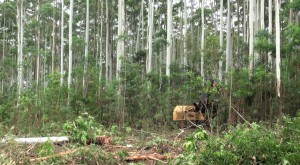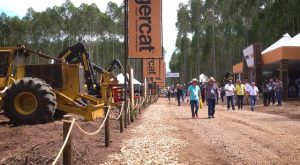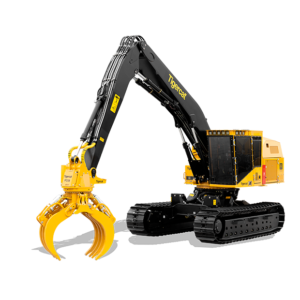The company produces packaging paper, board and corrugated boxes and also produces and sells pine and eucalyptus logs to sawmills and veneer plants throughout Brazil. Founded in 1899, Klabin has over 110 years of history in the papermaking business. Innovative and progressive, Klabin is a model company in its industry. BTB visited Klabin’s Monte Alegre operations in Parana and the Otacilio Costa Unit in Santa Catarina. With 24 Tigercat machines purchased over 2008-2009, both operations make extensive use of Tigercat machinery, producing pulp and saw logs on a massive scale at mind-boggling production rates.

Each front has satellite communications. The recently harvested block in the background is free of debris with very little soil disturbance. It will be prepped and planted within a couple of weeks.
The fronts
Klabin’s harvesting operations are organized into a number of independent business units responsible for production and maintenance. Each unit or front has a mobile office and employee area for meals, breaks and first aid. The offices are linked by satellite and radio to a head office. Each front also has a well-equipped mobile service facility with a spare parts inventory. Most machine maintenance and repair is carried out in field. There are five such fronts in Monte Alegre, each employing 36. The machines are triple shifted — the fronts run 24 hours per day, seven days per week. The harvesting systems consist of a Tigercat L870C feller buncher, one 625C or 635C six-wheel skidder and an LS855C leveling shovel logger. The processors are CAT 541 carriers equipped with 624 Waratah heads but Klabin has purchased one Tigercat H855C with a TH575 head. (This combination is proving to be 15-20% more productive.) The Tigercat machines work nearly 5 000 hours per year.

Each front has a mobile office and well equipped service vehicle.
Klabin acquired the Monte Alegre property in 1934 and commissioned the mill in 1946. Today it is the largest paper mill in the country, consuming 12 000 tonnes of fibre per day. As a major landowner in Parana, the fibre comes from Monte Alegre’s 132 000 hectares of pine and eucalyptus plantations. A 1 400 km network of permanent forestry roads, along with thousands of kilometers of secondary roads provide hauling access. Interspersed within the plantations are an additional 111 000 hectares of native forest interconnected by corridors. This natural forest supports a complete ecosystem.
“We know that when the animals at the top of the food chain are present, like the puma and bobcat, that the ecosystem is complete,” says Filipi Santin de Souza, communications and visitor relations manager at Monte Alegre. Klabin has identified over 400 species of birds, 90 species of mammals and 80 reptiles and amphibians in its forests. In addition, an 11 000 hectare Ecological Park protects samples of primitive ecosystems and serves as a research area and scientific breeding ground.
Filipi Santin explains that the plantations mainly consist of loblolly pine and hybrids of eucalyptus. The mill uses a mix of pine and eucalyptus chips. One of the main uses of the board produced at the mill is for tetra packs used in food, beverage and pharmaceutical packaging.
Felipe Alexandre Fuck is wood supply coordinator, a role which includes the management of harvesting, truck transport and road maintenance. “We have gone from five to 55 percent eucalyptus chip content in our pulp,” he says. “But the tetra packs need long fibre for strength so we will always have pine content.” Felipe Alexandre goes on to say that Monte Alegre’s fast growing eucalyptus, which can reach one cubic metre in a mere twelve years, has spurred the development of technology to utilize a higher proportion of short fibre chips. Additionally, Klabin is constantly improving the genetics of the clones, both from a growth and chemical composition standpoint and better matching the variations to the different soil types.
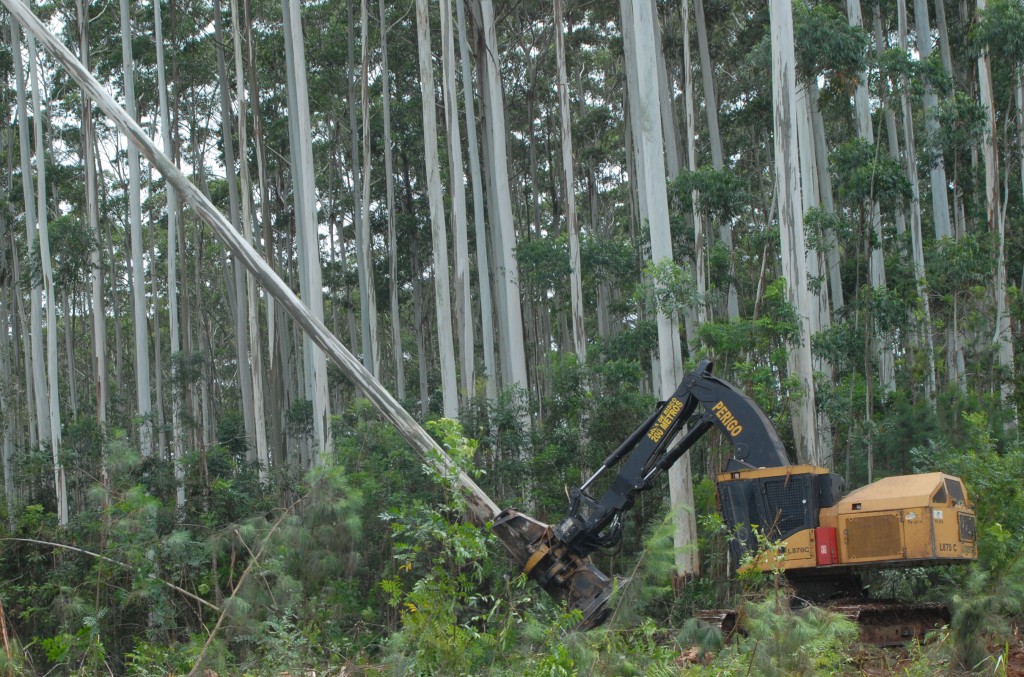
An L870C buncher fells large eucalyptus. Some of the trees are over 40 m tall but the operator is able to lay them down carefully, avoiding breakage.
Klabin’s operations are as challenging as any in the world, Felipe Alexandre explains, not only because of the difficult terrain conditions, high annual rainfall and the significant volume of large eucalyptus but also because of the variance from stand to stand. “We have many different ages, sizes and species that we are harvesting simultaneously,” says Felipe. Each front has a mobile office and well equipped service vehicle.
Currently there is a seven-year eucalyptus rotation for pulp. For eucalyptus saw logs the rotation has been reduced to twenty years, with thinning at seven and twelve years, but there is still a significant number of 25-30 year old towering eucalyptus stands remaining. As a consequence, production varies a great deal. Felipe rhymes off some numbers. “In a 27 year-old Eucalyptus saligna stand with 2,52 m3 average tree size, the front can produce 3 000 m3 per day. In 15 year-old loblolly pine, 1 200 to 1 500 m3 per day.”
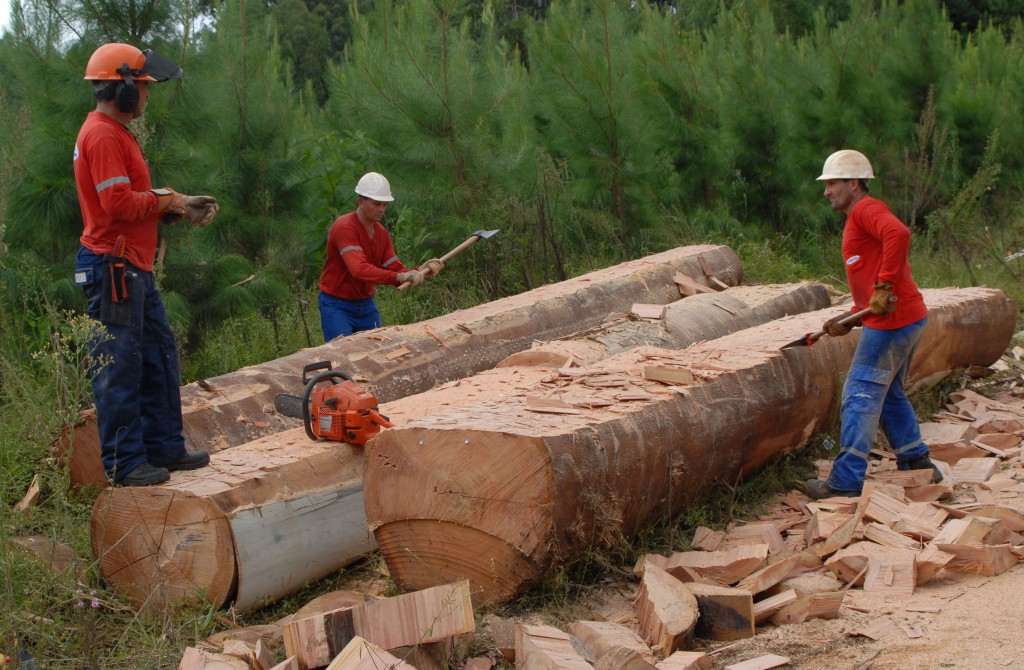
A road crew turns a recently felled tree into bridge material. These diameters are not uncommon in the older 25-30 year old stands.
The key?
The key to the whole system is the LS855C shovel logger. To fully understand its significance, we must step back and look at the whole system and how it evolved. Consultant, Antonio Carlos Antiqueira, explains that in 2006 it was decided a system change was required, driven in large part by the need for biomass.
“Before, the felling machines were too small and the big, high value trees were breaking when they were felled. After the trees were skidded, the broken parts were left in the cut block and it was very expensive to bring this material to the road,” says Antonio Carlos.
The L870C buncher solved the felling and breakage issues. The powerful machine handles the large wood and lays it down carefully, avoiding the damage that was so prevalent before. The next step was to make the system more productive and further improve fibre recovery per hectare.
“Klabin is the first to use a shovel logger in Brazil but we know the concept is not new. We spent a month in western Canada and the US to see the machines work,” says Antonio Carlos. Everyone involved in harvesting in Monte Alegre is convinced that not only is the shovel logger beneficial when working in concert with a skidder but in many cases, is actually more productive than a skidder. Antonio Carlos states, “We already saw several fronts in other companies operating only with shovel loggers, where according to them, until five swings is more productive and lower cost compared with a skidder. Some studies developed in USA and Canada also reached the same conclusion but here at Klabin, we do not have enough supporting data yet to prove it in our operations.”
The problem with skidding goes back to rain and terrain. Although the grades are far milder than typical Canadian west coast terrain, in certain conditions, even a six-wheel skidder is not capable of retrieving all the wood, especially large wood. The shovel logger can be strategically placed in challenging parts of the block to shovel the trees to a more favourable position, drastically improving skidder productivity while reducing rutting, erosion and soil damage.
“The shovel logger increases skidder productivity by an average of 25%,” explains Felipe Alexandre. “Of course if the skidder cannot get to the wood at all, the shovel becomes 100% more productive.” With the current Tigercat system, fibre recovery is 20% higher, due in large part to the LS855C, which retrieves trees that skidders simply can’t get to.
Or the joker…
It is difficult to quantify the full contribution of the LS855C. Antonio Aparecido de Castro is supervisor of fronts one and five. “Without using the shovel logger in the front, we can lose up to 30% overall production. The shovel logger is like the joker or wildcard. It can fit into many different roles and positions. It is not what you gain by having one so much as what you lose by not having one. In steeper terrain, it is the skidder that becomes the complementary machine,” says Antonio, adding that the skidder is mainly used in “ideal” circumstances.
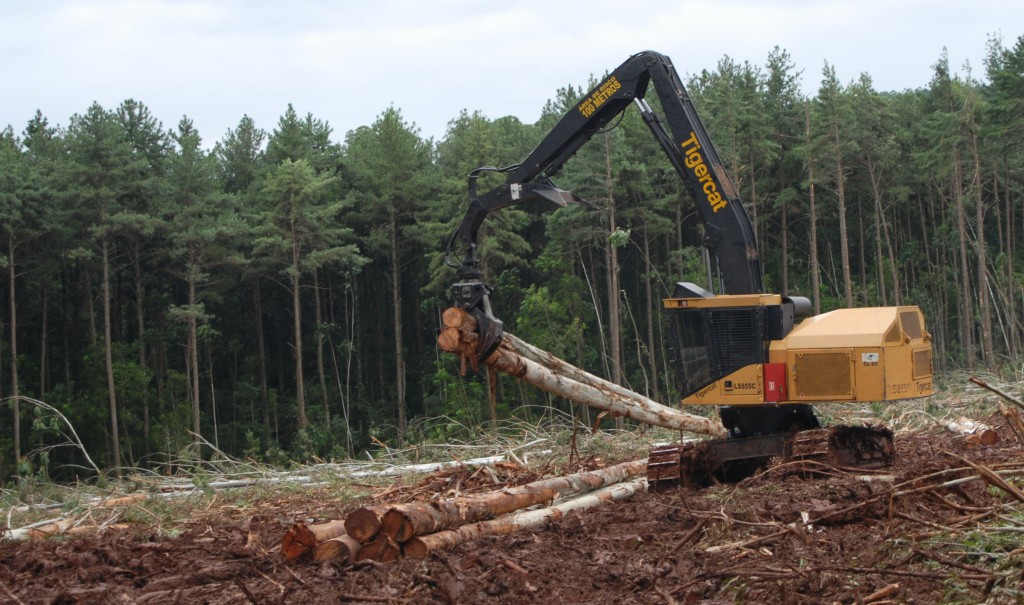
The joker…The LS855C is being used to reorient the bunches 90 degrees and is shoveling around 80 m to the deck in very wet soil.
The wildcard functions of the LS855C are wide ranging. At roadside it optimally positions logs for the processors. The skidder approaches the decking area, drops the load and immediately returns to the cut block in reverse with no wasted movement. Then the LS855C quickly stacks the trees for the processor at a slight angle rather than perpendicular to the road. When the processor picks a tree from the pile, it reorients the tree perpendicular to roadside, freeing the top from the pile for easier feeding. Felipe Alexandre says that this angled placement method increases processor productivity by 15%.
Sometimes there is not enough road frontage to physically accommodate the unprocessed trees. This typically happens when a cut block is deeper than it is wide or when a secondary road is put out of play on account of heavy rain. The solution? Stack higher. A skidder cannot stack trees 3,5 m high but the shovel logger can. Similarly, after processing the LS855C can stack the processed logs higher. This function is important since the pulp logs dry at roadside for 30 days to make hauling cost effective.
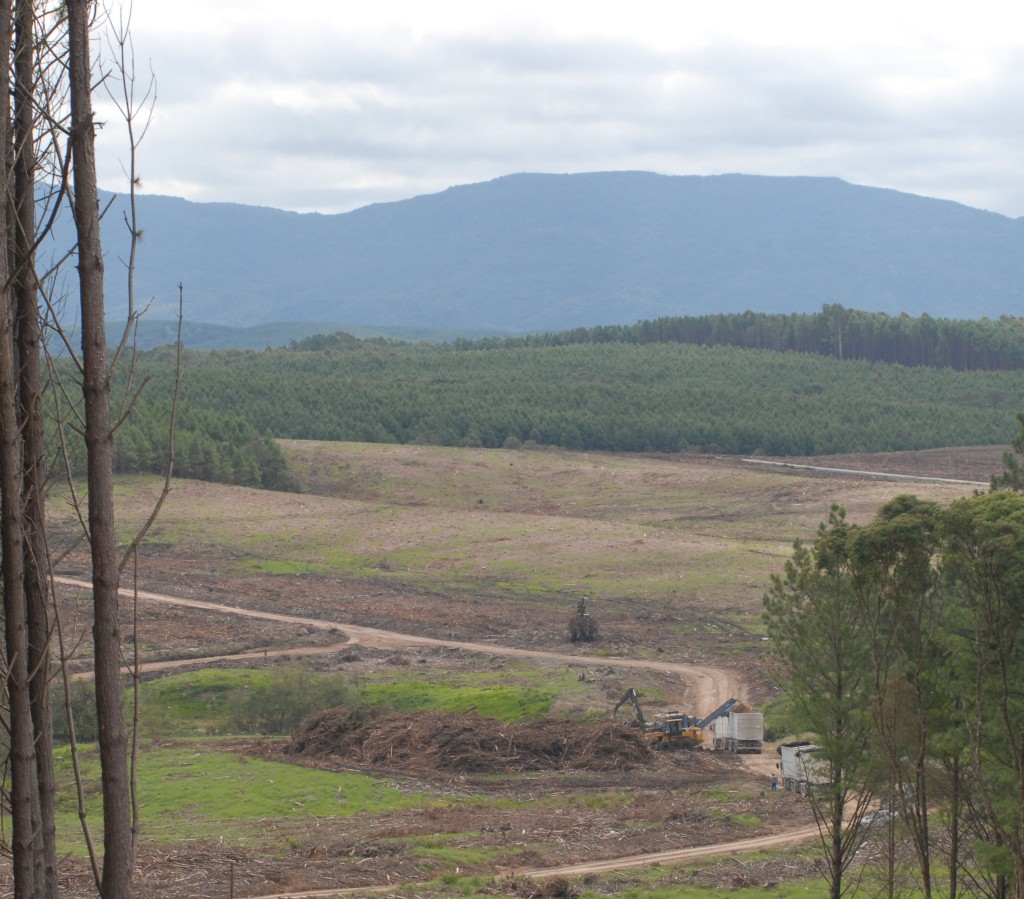
The grinders work at central chipping locations. Klabin’s harvesting systems were designed around the requirement to capture all the biomass. Among other brands, Klabin runs two CBI grinders.
There is also the ‘15 metre’ issue. The trees are planted right to the edge of the road but the processors require a 15 m deep decking area along the length of the road. This allows placement of two rows of 6 m saw logs in front and one row of 3,6 m pulpwood in behind. In order to achieve the 15 m buffer, the felled trees must be pulled backwards away from the road, an awkward task for the skidder but a very simple one for the LS855C.
Sometimes the wood is felled and bunched in a certain direction. Then plans change, requiring the use of a different hauling road. This is a bad scenario for a skidder but an easy fix with the shovel logger. In one turn the LS855C can change the direction of the felled bunches while moving them nearly 20 m closer to the road. And in very large, hard to handle timber, the shovel logger can reposition felled trees, allowing the buncher operator to work more quickly without having to worry about perfect control and placement of each tree.
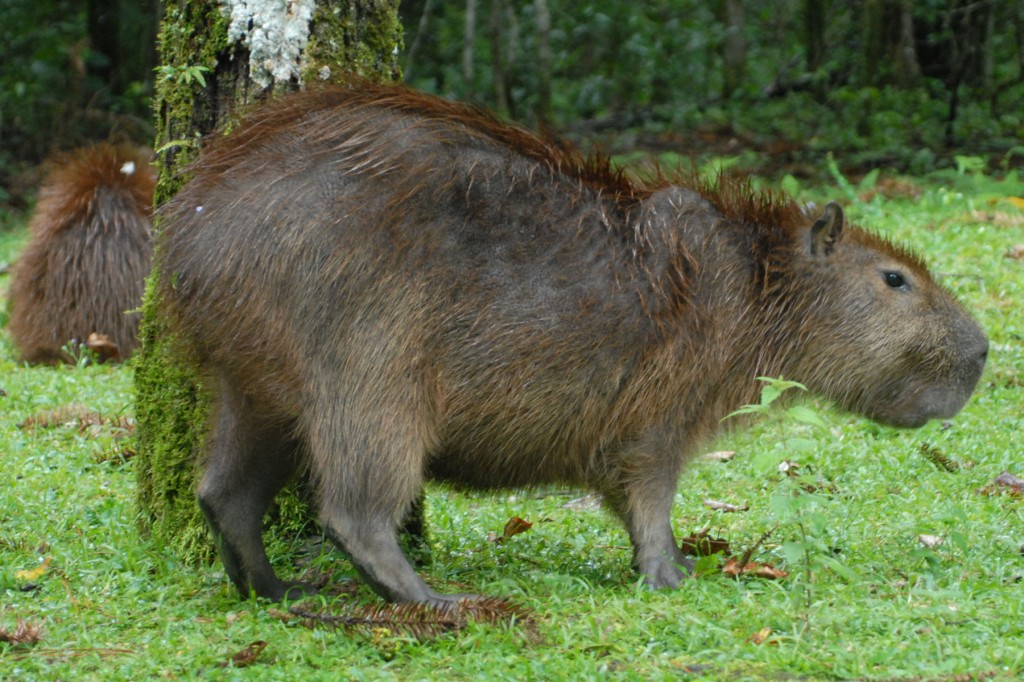
Klabin’s forests support an ecosystem with over 90 species of mammals.
The Santa Catarina Pine operations
Klabin’s second largest plant, the Otacilio Costa Unit in Santa Catarina has been operating since 1958 and specializes in the manufacture of packaging paper. The harvesting operations are quite different from Monte Alegre. Exclusively pine, the wood is generally smaller and the terrain is decidedly worse. (The term ‘horrible’ is thrown around a lot when describing the soil.) Overall average size is 0,45 m3 per stem. The trees are planted on 2,5 x 2,5 m espacement, for a total of 1 600 trees per hectare, and clear felled at 18 years. There is no thinning in the rotation. The soil is poor and rocky in some areas, the terrain is rolling with steep areas and the harvesting sites tend to get very soft after rainfall. The region receives a high amount of rainfall.
Cristiano Miers is harvesting manager for Otacilio Costa (Felipe Alexandre’s counterpart.) “We work two shifts not three. Our costs are lower and our availability is higher because there are less people on a machine and they stay more time with the machine and respect the machine more. Also it is less people to manage.”

In this application the LS855C is working with the skidder – forwarding trees from a steep section in the back of the block to the 625C.
A front produces 1 800 tonnes per day (1 t = 1 m3) and can achieve as much as 2 200 tonnes – phenomenal production rates, especially taking into account the adverse soil conditions. Cristiano stresses that the conditions are not easy especially for skidding. Tigercat six-wheel skidders can pull about nine tonnes in relatively good terrain but half that in steep, soft ground. Although the fronts were specified for average maximum skid distances of 200 m, in reality distances are creeping up past 240 m, putting further pressure on the skidding component.
The L870C bunchers cut 350 trees per hour. About 30% of the tree goes to saw logs and the rest to pulp. The saw logs can only stay on the ground for twelve hours, making hauling logistics and harvesting planning difficult in wet weather conditions.
The four harvesting fronts work two shifts per day from 5:00 am to midnight. The fleet of machines maintains 75% overall availability. Isolating the Tigercat machines, availability is 85-90%. The Otacilio Costa Unit is considered to be one of the lowest cost per tonne pine operations on the planet.
Biomass
After all the logs and pulpwood have been hauled away, the biomass piles remain at a distance of 15- 20 m from the road. The material is transported to an intermediate yard and stacked in 5 m high piles in order to concentrate the activity of the grinders. Occasionally the material is chipped right into a truck, but more often the chips are stockpiled. This avoids the added complication of truck logistics and keeps the grinders working. The chips are consumed in the mills for power generation.
The extensive use of the shovel loggers minimizes soil compaction and the removal of all debris provides a clean slate for easier replanting with minimal site preparation. Blocks are replanted within one week to one month after harvesting — before weeds have a chance to establish.
Sustainability
Klabin commands a large measure of credibility regarding sustainability of its forest operations thanks to a strong focus on scientific understanding. Klabin has consciously practiced sustainability since the 1940s, long before such concepts were a part of the common consciousness. Although her background is in genetics, Ivone Satsuki Namikawa is currently involved in forest sustainability. She explains that sustainability is a far-reaching concept that goes well beyond FSC certification. (Klabin’s Parana forests were among the first in South America to be certified by the Forest Stewardship Council.)
Ivone says that the environmental and ecological aspects of forest sustainability are the easy part. “My job is also to engage all stakeholders. It is not just employees but neighboring landowners and villages. Klabin’s operations can impact all of these people positively or negatively.” With the scale of the operations, a seemingly small decision in one place can have a large effect elsewhere. Ivone must sort through it all and ensure stakeholders are not adversely affected. She explains that environmental sustainability is possible when socio-economic development is properly executed.
Machine availability
Constant tinkering with the harvesting fronts and the other interrelated systems creates incremental efficiency improvements. “In Klabin’s operations, saving a few cents per tonne makes a big difference,” says Felipe Alexandre. Machine reliability and availability are of central importance. “We can plan our production and trucking more easily because the Tigercat machines are very reliable compared with other brands.”
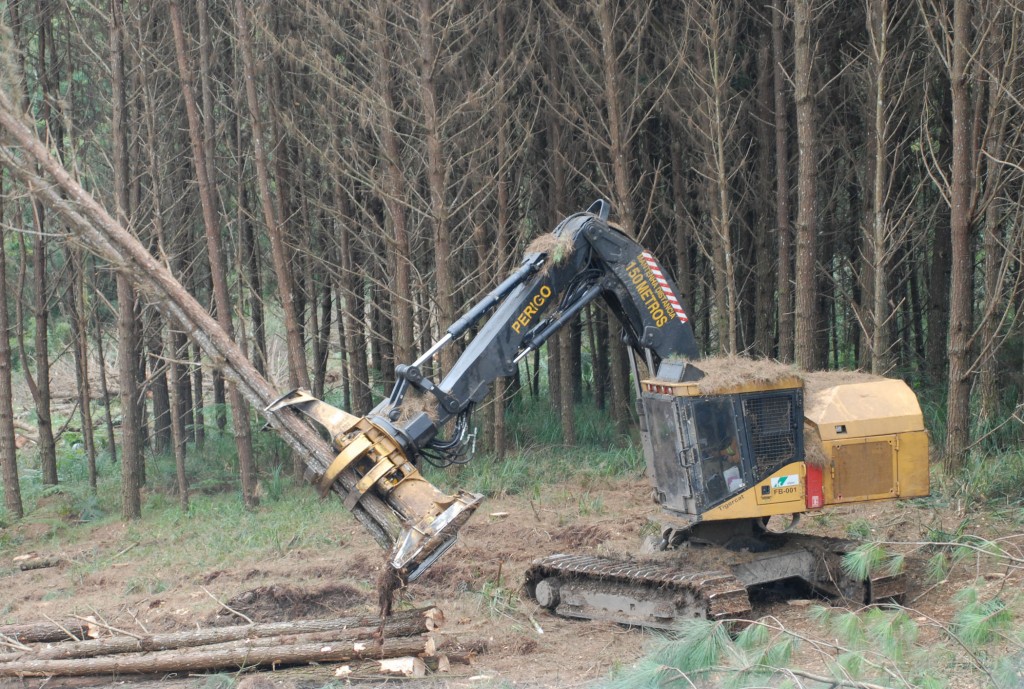
The Santa Catarina pine operations are extremely efficient.
The Tigercat machines are approaching 15 000 working hours. To improve availability, Monte Alegre may emulate Otacilio Costa’s schedule. “One of my ideas is to switch from three operators to two with one night maintenance shift to fix even the tiniest problems with the machines,” says Felipe Alexandre. “With this concept I think we can increase the machine availability from what it is now even as the machines age.”
Maintenance manager, Edilson Daniliszyn, who looks after a fleet of 90 machines located at Monte Alegre and Otacilio Costa, concurs. “20 000 hours was the original goal for machine life. Management is now asking if 25 000 to 30 000 hours is possible. I believe it is but operations will have to be altered, with more operator training or changing the shift schedule — today there are six different operators for each machine. Another point is the characteristics of our forest with tall and heavy trees that can weigh up to six tonnes and reach more than 35 meters in height, often in steep areas. Our machines operate in a 24 hour rhythm, seven days per week. This speeds equipment wear and makes maintenance difficult. All this makes it challenging to optimize maintenance and availability.”
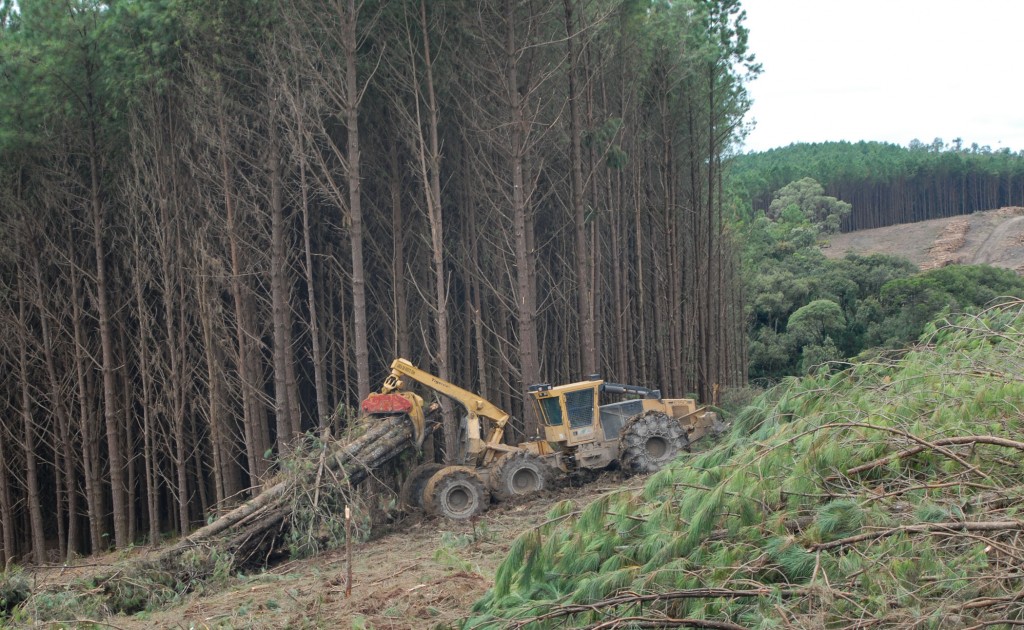
The Santa Catarina fronts consistantly produce 1800 tonnes per day.
Edilson emphasizes the importance of onsite service. He believes that by tying a crew responsible for maintenance, lubrication, refueling and spare parts to each front, machine availability is improved. “Also it is very complicated and expensive to transport machines back to the shop in Lagoa, situated ten to 100 km from the operations. This is only done when it is impossible to fix the machine in the forest.”
Although his service department is extremely capable with extensive facilities and a substantial spare parts stock, Edilson appreciates having Latin Equipment on hand when performing major repair work such as adjusting or eplacing hydraulic components and notes that, “Latin is very responsive when we require them for parts and service.”
Often working with equipment suppliers in an open collaboration, Edilson and his team are always looking for modifications to reduce daily maintenance costs and make the machines better suited to the employees and the operations. “It is a good partnership between Klabin, Tigercat and Latin. It improves our operation and Tigercat’s equipment. There are no secrets and we always try to share the challenges and knowledge to reach goals together.” Later he adds, “It is clear that the Tigercat designers are thinking not just about operations but also about maintenance, durability of components and ease of access to the components in maintenance interventions. In these areas, the Tigercat machines are very strong. Tigercat is definitely at the top in this respect.”












